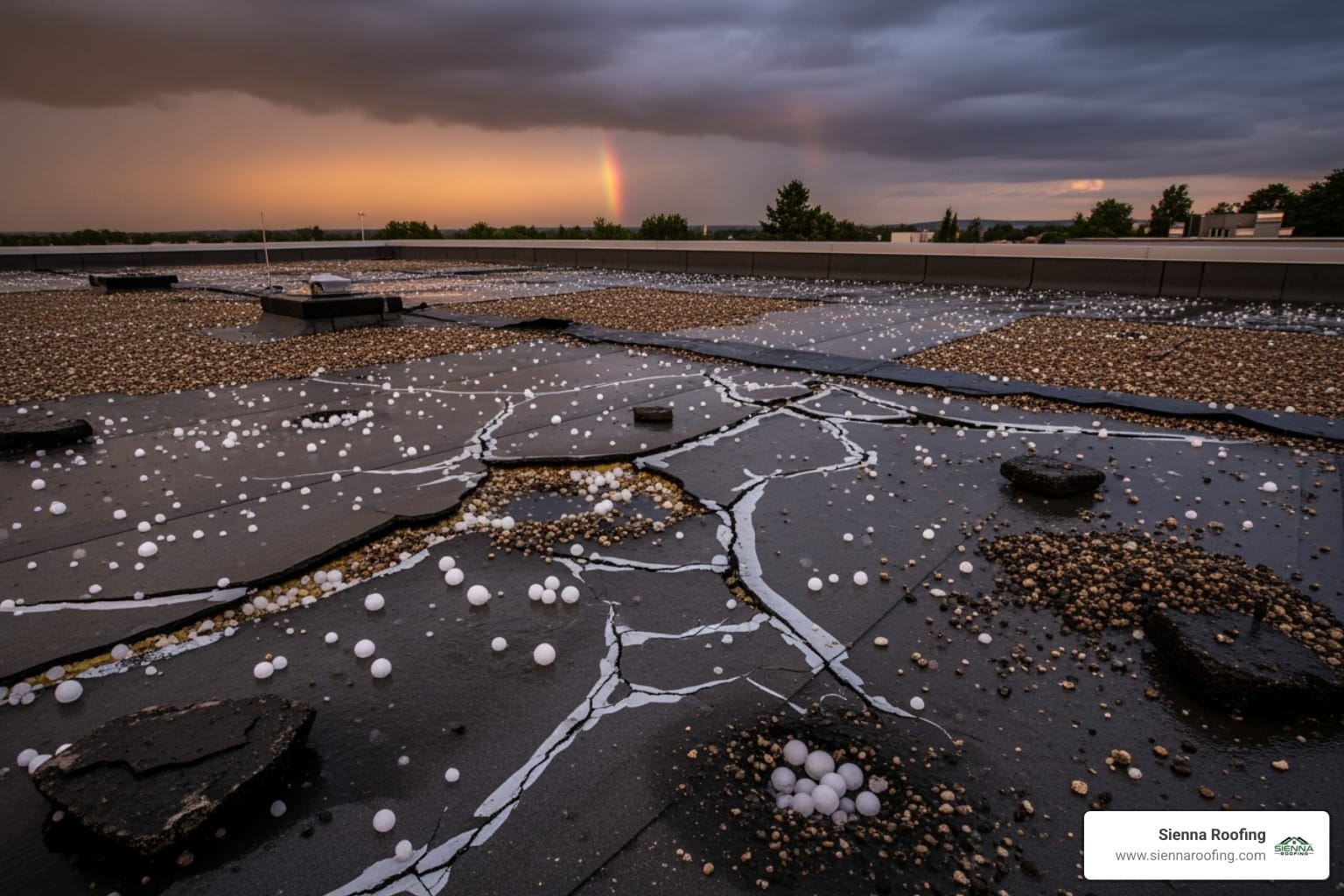Why Hail is a Major Threat to Your Texas Flat Roof
Flat roof hail damage occurs when hailstones strike the membrane, causing punctures, cracks, and fractures that compromise its waterproofing integrity. Unlike sloped roofs that deflect impacts, flat roofs absorb the full force of each hailstone at a 90-degree angle. This vulnerability is compounded by poor drainage, which allows water to pool in damaged areas, and the potential for hidden damage beneath an intact-looking surface.
Texas leads the nation in hail events, with over 1,123 recorded in 2023 alone. As a leading roofing company in Sugar Land, we’ve seen how quickly ignored hail damage escalates from minor membrane issues to costly interior water damage, especially from the golf ball and tennis ball-sized hail common in our region.
What starts as small punctures becomes a pathway for water infiltration, leading to saturated insulation, mold growth, and structural decay. My name is Andre Castro, and my experience managing storm repairs across the Houston Metro area has shown me that early detection is critical to preventing minor damage from becoming a major structural problem.

Explore more about flat roof hail damage:
- hail damage repair cost
- hail damage to asphalt shingles
- how to tell if roof needs repair from hail damage
The Science of Destruction: Why Flat Roofs Take a Direct Hit
When a hailstone hits your flat roof, physics becomes your enemy. Unlike sloped roofs that deflect impact, flat roof hail damage occurs because every hailstone strikes at a 90-degree angle. Your roof absorbs the full kinetic energy, taking the punishment head-on.
The destruction continues after the storm due to pooling water. Without a slope, water collects in the spots where hail compromised the membrane, turning tiny punctures into major leaks.
The hailstone’s size, density, and shape determine the extent of the damage. A jagged, golf ball-sized chunk of ice can punch through a membrane, while a smaller stone might only leave a dent. Material resistance varies: TPO typically resists hailstones up to 1¾ inches, EPDM up to 2½ inches, and gravel-surfaced Built-up roofs handle smaller stones well but can have gravel displaced by larger hail.
Your roof’s age and condition multiply the damage potential. UV exposure and weathering make materials brittle, turning what might have been minor damage on a new roof into a major failure on an older one. This is why keeping your roof in good condition is essential for resiliency against Texas storms.
Understanding how hailstones form and cause damage clarifies why they pack such a punch. The combination of direct impact, pooling water, and an aging roof system is a recipe for costly repairs.
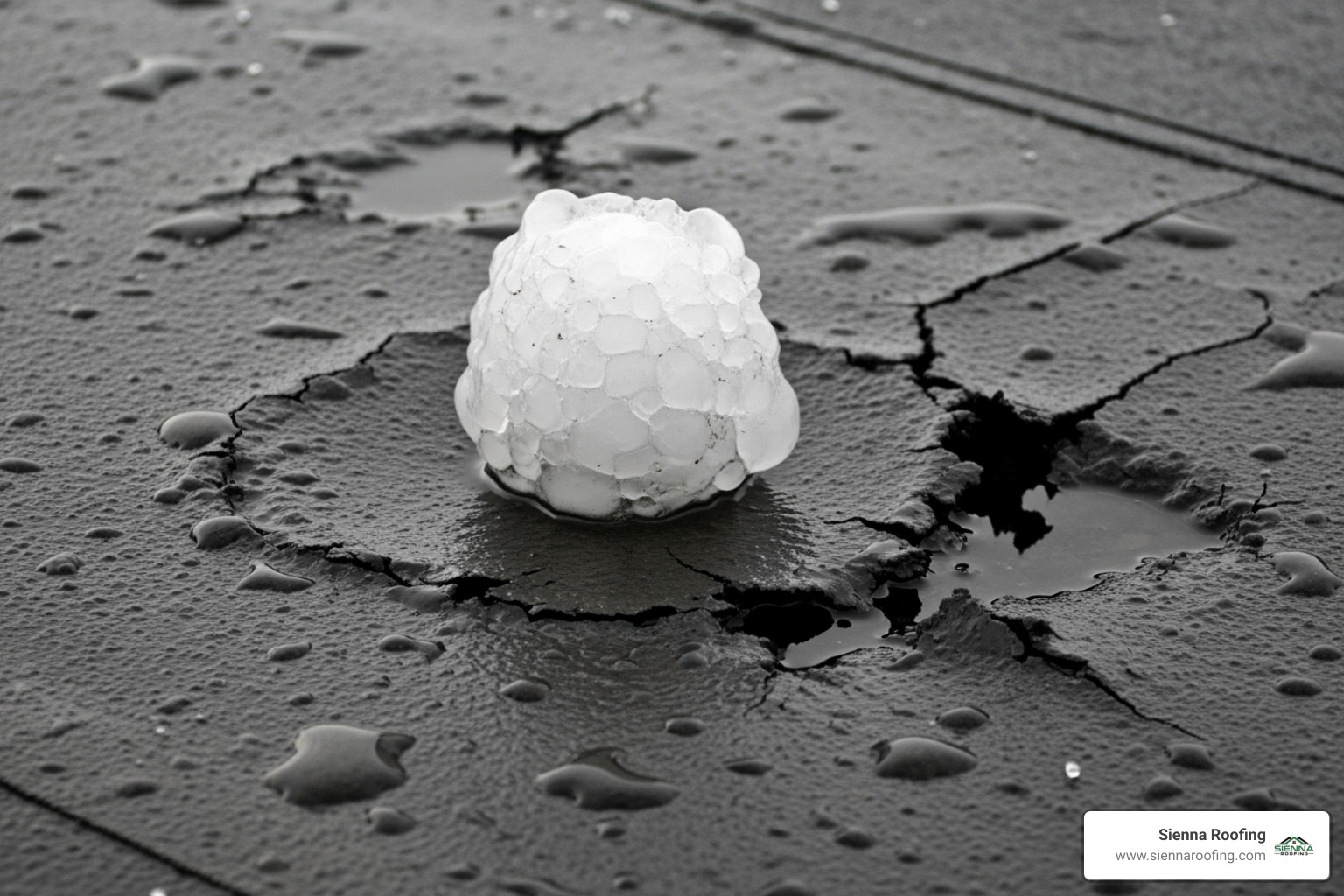
How to Spot Hail Damage on Different Flat Roof Systems
After a hailstorm, flat roof hail damage can be sneaky. An intact-looking roof might hide serious issues that lead to leaks and costly repairs months later. This is why a professional inspection is crucial. We look beyond the main surface to check for damage on gutters, vents, and flashing, as these are often the first clues your roof was hit.
Different systems show damage in unique ways. While you can learn the signs, we always recommend having a professional roofing contractor in Sugar Land assess any suspected damage.
Recognizing Hail Damage on TPO & PVC Roofs
When hail strikes these single-ply membranes, look for:
- Punctures and tears: Visible holes from larger hailstones.
- Scuffs and scrapes: Marks from smaller, wind-driven hail.
- Semicircle patterns: Crescent-shaped indentations or cracks that are clear signs of impact.
- Hidden damage: Hail can shatter the underlying reinforcement fabric even if the surface looks fine, compromising the membrane’s strength and leading to future leaks.
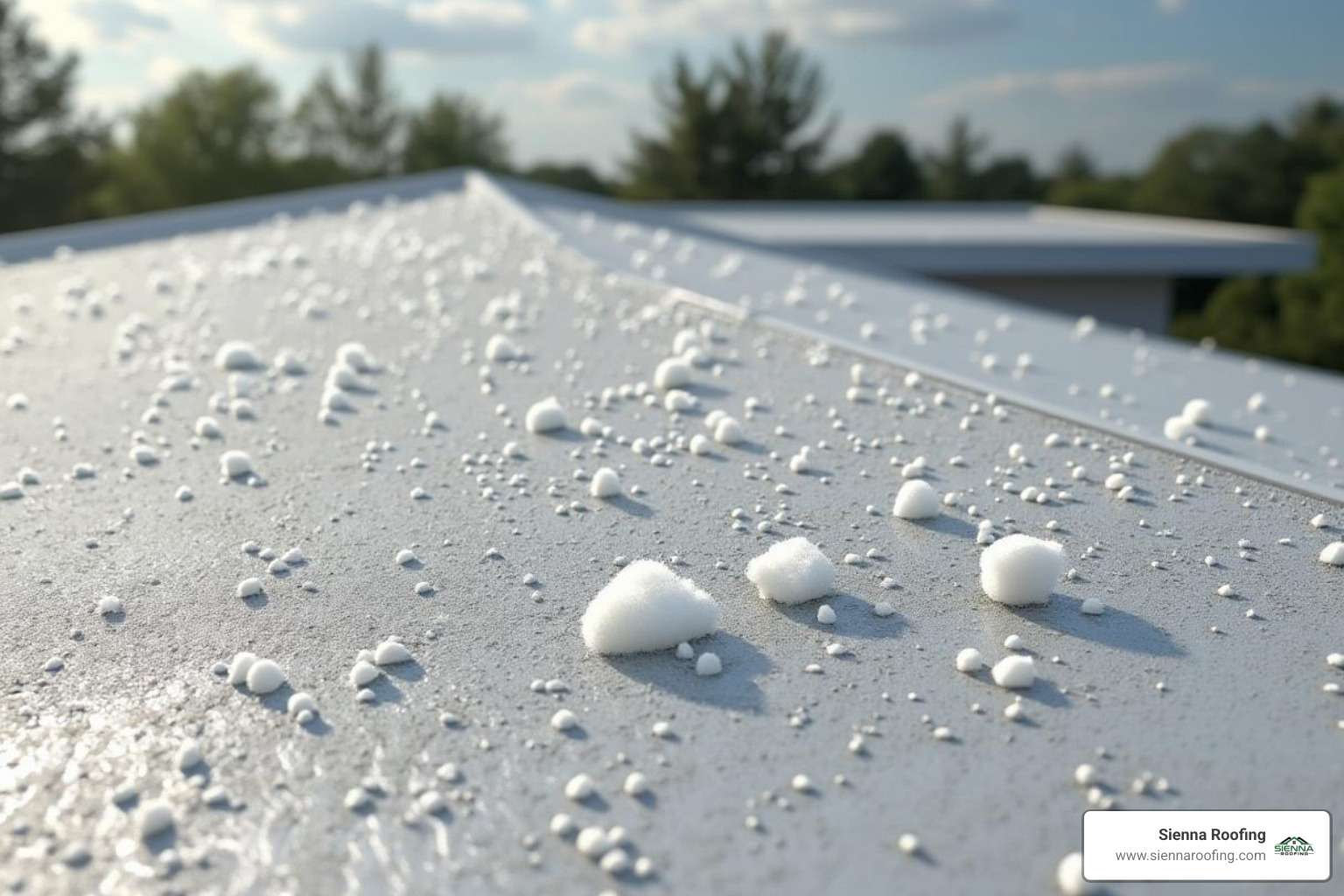
Identifying Damage on EPDM (Rubber) Roofs
EPDM’s flexibility helps, but it’s still vulnerable. Key signs include:
- Cracks and splits: The membrane can crack upon impact, especially on older, less flexible roofs.
- Punctures over soft substrate: If the underlying insulation is soft, hail can easily punch through the membrane.
- Divots in insulation: Impacts can create depressions in the insulation below, causing water to pool and leading to eventual failure.
- Loss of adhesion: Severe impacts can cause the membrane to bubble or pull away from the roof deck.
Assessing Built-Up Roof (BUR) and Modified Bitumen Damage
These multi-layer systems have natural resilience, but large hail can still cause problems. Look for:
- Displaced gravel: Patches where gravel has been knocked off, exposing the vulnerable asphalt or felt layers beneath.
- Membrane bruising and blistering: Hail can bruise the asphalt layers, creating soft spots that later turn into blisters as moisture gets trapped.
- Surface cracks: Severe impacts can crack the surface, especially on aged materials.
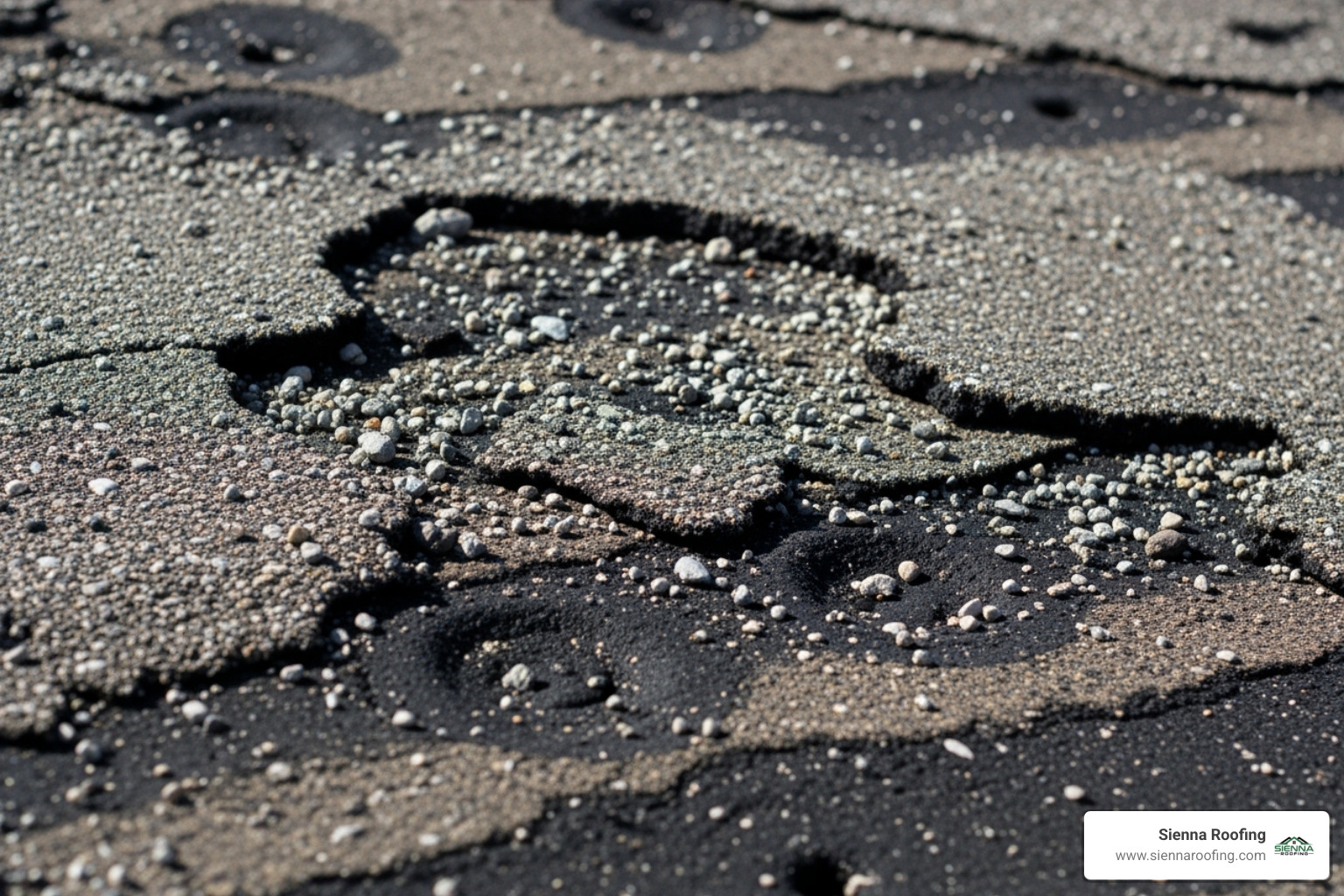
Your Post-Storm Action Plan: What to Do Immediately
After a storm, your actions can mean the difference between a manageable repair and a disaster. With flat roof hail damage, time is not on your side, as water infiltration can quickly escalate minor issues. Here’s your plan:
- Prioritize Safety: Never climb onto a potentially damaged roof. It can be slippery or have weak spots. Inspect for damage safely from the ground.
- Document Everything: Take photos and videos of any visible damage to your roof, gutters, and vents. Note the date and time of the storm.
- Minimize Interior Damage: If you see leaks, place buckets to catch water and move valuables. This shows your insurer you took steps to prevent further loss.
- Call a Professional: Contact a trusted roofer like Sienna Roofing for an urgent inspection. We can identify the full extent of the damage, including hidden issues, which is crucial for your insurance claim.
- Contact Your Insurer: Report the potential damage as soon as possible to start the claims process. Most Texas policies have a one-year deadline, but prompt reporting is always best.
Ignoring the problem is the biggest risk. Minor hail damage can lead to saturated insulation, mold, and structural rot. The longer you wait to address the issue, the more expensive the fix becomes.
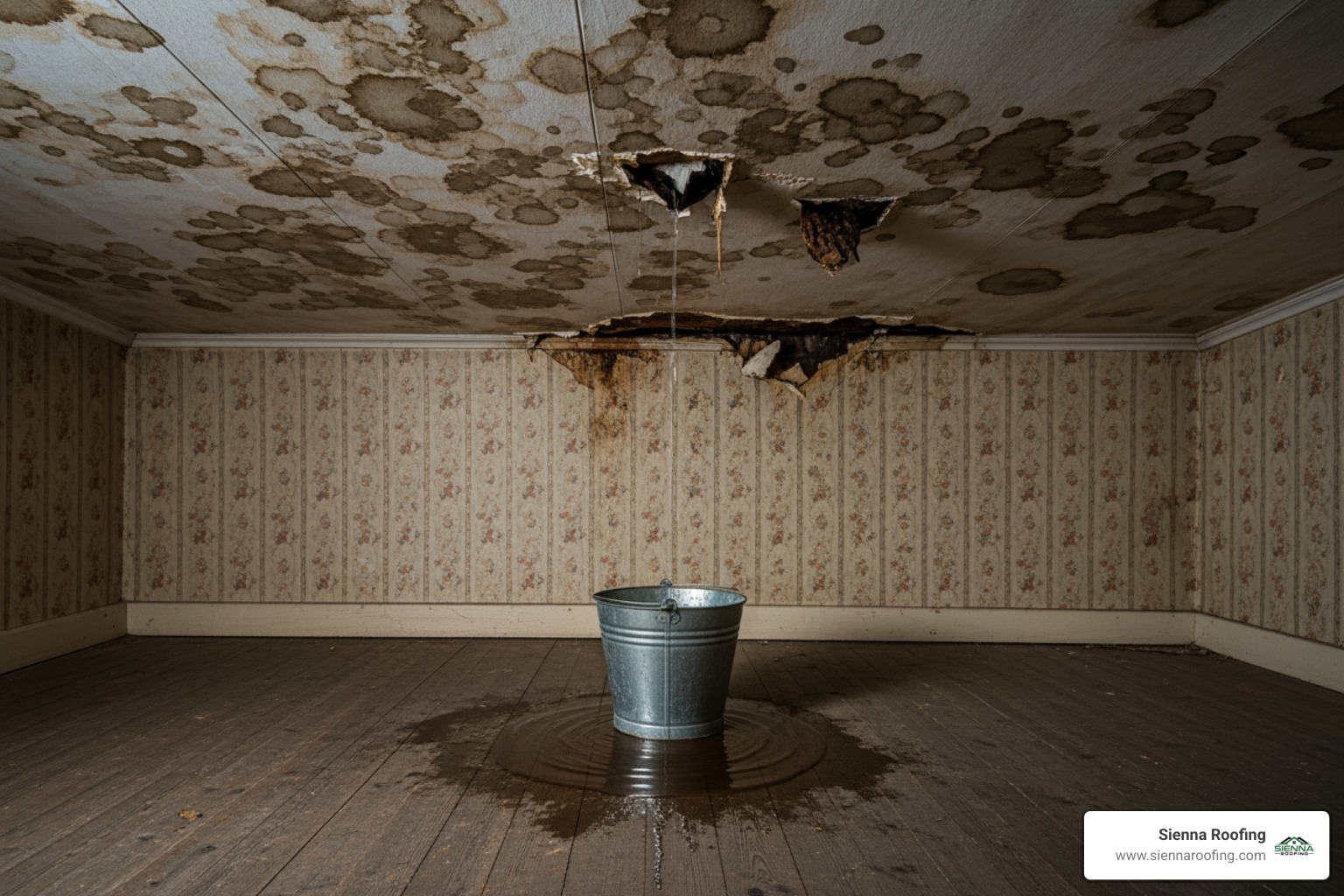
The Long-Term Consequences of Unrepaired Flat Roof Hail Damage
Unrepaired flat roof hail damage is like a crack in a windshield—it only gets worse. The consequences are severe and costly:
- Compromised Waterproofing: The smallest puncture becomes a gateway for moisture, leading to leaks.
- Saturated Insulation and Mold: Water-soaked insulation loses its effectiveness, raising energy bills. The damp environment becomes a breeding ground for mold, posing health risks and requiring expensive remediation.
- Structural Decay: Moisture reaching the roof deck causes rot, weakening the entire structure and potentially leading to collapse.
- Voided Warranties: Most manufacturer warranties require prompt repair of storm damage. Ignoring it can leave you responsible for costs that would have been covered.
A small repair today prevents a massive expense tomorrow. Taking hail damage seriously from the start is the most cost-effective approach.
Navigating Insurance Claims for Flat Roof Hail Damage
Filing an insurance claim for flat roof hail damage can seem daunting, but the right preparation makes a significant difference. After you file, your insurer will send an adjuster. We recommend having your roofing contractor present for this visit to ensure no damage is overlooked.
Your post-storm documentation—photos, videos, and notes—is your strongest evidence. Understand your policy, whether it’s Actual Cash Value (ACV), which pays the depreciated value, or Replacement Cost Value (RCV), which covers the full replacement cost. RCV is generally preferred.
Texas has more hail than any other state, with over 1,123 events in 2023 alone. Insurers are experienced with these claims but can be cautious. You can find more data on Texas hail storm statistics.
Common Problems in a Flat Roof Hail Damage Claim
Be prepared for potential challenges during your claim:
- Functional vs. Cosmetic Damage: An adjuster might dismiss dents as cosmetic, but we can demonstrate how they compromise waterproofing and are functional damage.
- Pre-existing Conditions: Insurers may argue damage existed before the storm. Your immediate documentation and a history of roof care help counter this.
- Underpaid Claims: Initial estimates can be too low if they miss hidden damage, use outdated pricing, or suggest inadequate repairs. A detailed estimate from your contractor is your best tool for negotiation.
We work with you and your adjuster to ensure all damage is accurately assessed and documented. Our goal is to help you receive fair compensation to restore your roof properly, protecting the investment underneath it.
Frequently Asked Questions about Flat Roof Hail Damage
Here are answers to the most common questions we receive about flat roof hail damage.
Can I repair minor hail damage on my flat roof myself?
We strongly advise against it. Flat roof repairs require specific materials and techniques to ensure a proper seal. Using the wrong product can worsen the damage. Furthermore, DIY repairs are dangerous, can void your manufacturer’s warranty, and may complicate your insurance claim. It’s always best to leave it to a professional.
What are the most hail-resistant flat roofing materials?
While no roof is completely hail-proof, some materials offer better resistance:
- EPDM (Rubber): Its flexibility allows it to absorb impacts from hail up to 2½ inches.
- Built-Up Roofs (BUR): The gravel surfacing acts as a protective armor against most hail.
- TPO and PVC: Newer, thicker membranes offer good resistance, especially when installed over high-density cover boards, which improve impact resistance for all systems.
How long do I have to file an insurance claim for hail damage in Texas?
Most Texas policies give you up to one year from the date of the storm. However, we recommend filing as soon as possible. Prompt filing makes it easier to assess the damage and prevents insurers from arguing that you allowed secondary damage (like leaks or mold) to occur by waiting too long to make repairs.
Protect Your Investment with Professional Storm Damage Repair
When hailstones pummel your flat roof, they threaten your entire investment. As we’ve covered, flat roof hail damage poses unique challenges, from direct impacts to the pooling water that turns minor punctures into major leaks, mold, and structural decay.
Ignoring a small crack today can lead to devastating and expensive consequences tomorrow. The good news is you don’t have to face this alone. At Sienna Roofing, we understand the stress of storm damage. We are your partners in protecting what matters most.
Our team specializes in comprehensive flat roof hail damage assessments across Sugar Land, Missouri City, Katy, and the greater Houston area. We spot the damage others miss, document everything for your insurance claim, and restore your roof to peak condition. Our 100% satisfaction guarantee is our commitment to your peace of mind.
Don’t let hail damage compromise your property. We can help you steer this challenge with confidence, ensuring your investment is protected for years to come.
